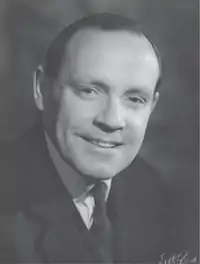Robin Coombs
Robert Royston Amos Coombs FRS FRCPath FRCP (9 January 1921 – 25 January 2006)[1] was a British immunologist, co-discoverer of the Coombs test (1945) used for detecting antibodies in various clinical scenarios, such as Rh disease and blood transfusion.[2]
Robin Coombs | |
|---|---|
 Robin Coombs | |
| Born | 9 January 1921 London, England |
| Died | 25 January 2006 (aged 85) Cambridge, England |
| Nationality | British |
| Alma mater | University of Edinburgh King's College, Cambridge |
| Known for | Coombs test; Gell–Coombs classification |
| Awards | Gairdner Foundation International Award (1965) |
| Scientific career | |
| Fields | Immunology |
| Institutions | Corpus Christi College, Cambridge |
Biography
He was born in London and studied veterinary medicine at the University of Edinburgh. In 1943 he entered King's College, Cambridge, where he commenced work on a doctorate, which he gained in 1947. Before finishing his doctorate, he developed and published methods to detect antibodies with Arthur Mourant and Robert Russell Race in 1945.[3] This is the test now referred to as the Coombs test, which, according to the legend, was first devised while Coombs was travelling on the train.[4]
Coombs became a professor and researcher at the Department of Pathology of University of Cambridge, becoming a Fellow of Corpus Christi College, and a founder of its Division of Immunology. He was appointed the fourth Quick Professor of Biology in 1966 and continued to work at Cambridge University until 1988.[4] He is reported to have said that "[r]ed blood cells were primarily designed by God as tools for the immunologist and only secondarily as carriers of haemoglobin".[5]
In November 1956, Coombs founded the noBritish Society for Immunology alongside John H. Humphrey, Bob White, and Avrion Mitchison. He was an honorary member of the British Society for Immunology.[6]
He received honorary doctoral degrees by the University of GuelphCanada, and the University of Edinburgh and was a Fellow of the Royal Society of the United Kingdom (1965), a Fellow of the Royal College of Pathologists and an Honorary Fellow of the Royal College of Physicians.
Coombs was married to Anne Blomfield, his first graduate student. They had a son and a daughter.[4]
Works
The Coombs test, which he developed and published together with Arthur Mourant and Robert Russell Race in 1945, has formed the base of a large number of laboratory investigations in the fields of hematology and immunology.[3][4][7]
Together with Professor Philip George Howthern Gell, he developed a classification of immune mechanisms of tissue injury, now known as the "Gell–Coombs classification", comprising four types of reactions.[8]
Together with W.E. Parish and A.F. Wells he put forward an explanation of sudden infant death syndrome (SIDS) as an anaphylactic reaction to dairy proteins.[9]
References
- Lachmann, P.; Waldmann, H. (2009). "Robert Royston Amos (Robin) Coombs. 9 January 1921 -- 25 January 2006". Biographical Memoirs of Fellows of the Royal Society. 55: 45–58. doi:10.1098/rsbm.2008.0021.
- "Robert Royston Amos Coombs". Munks Roll – Lives of the Fellows. Royal College of Physicians: Royal College of Physicians. XII: 584. 6 June 1967. Retrieved 2 February 2018.
- Coombs RR, Mourant AE, Race RR (1945). "Detection of weak and "incomplete" Rh agglutinins: a new test". Lancet. 246 (6358): 15–6. doi:10.1016/S0140-6736(45)90806-3.
- Pincock S (2006). "Robert Royston Amos (Robin) Coombs". Lancet. 367 (9518): 1234. doi:10.1016/S0140-6736(06)68528-0.
- Kasfiki, Eirini; et al. (2019). 250 cases in clinical medicine. Elsevier. p. 879.
- "Honorary members". www.immunology.org. British Society for Immunology.
- Coombs RR (1998). "Historical note: past, present and future of the antiglobulin test". Vox Sang. 74 (2): 67–73. doi:10.1159/000030908. PMID 9501403.
- Gell PG, Coombs RR (1963). Clinical Aspects of Immunology. London: Blackwell.
- Coombs RR, Parish WE, Walls AF (2000). Sudden Infant Death Syndrome: Could a healthy infant succumb to inhalation-anaphylaxis during sleep leading to cot death?. Cambridge Publications Ltd. ISBN 0-9540081-0-3.
External links
- The Independent 6 March 2006
- New York Times
- Robin Coombs on the History of Modern Biomedicine Research Group website